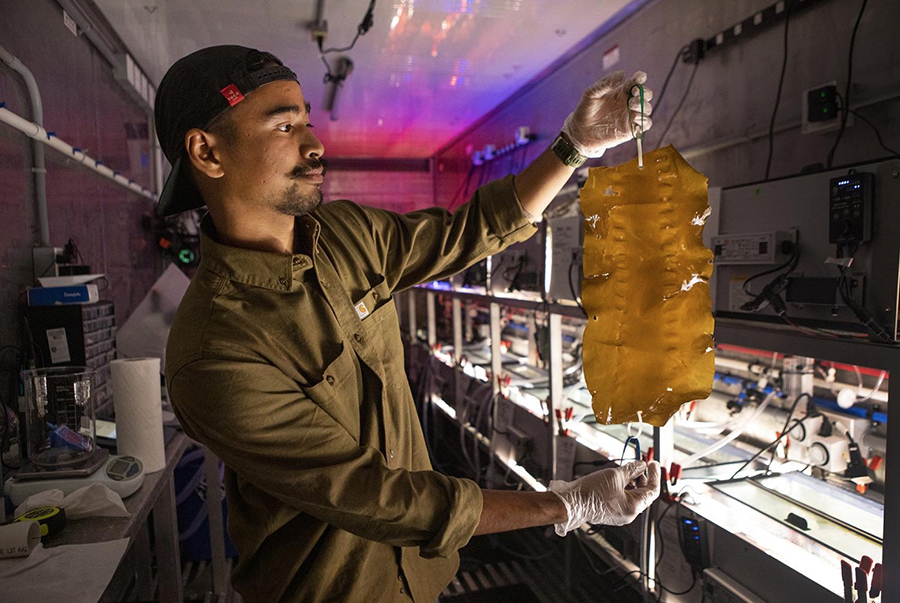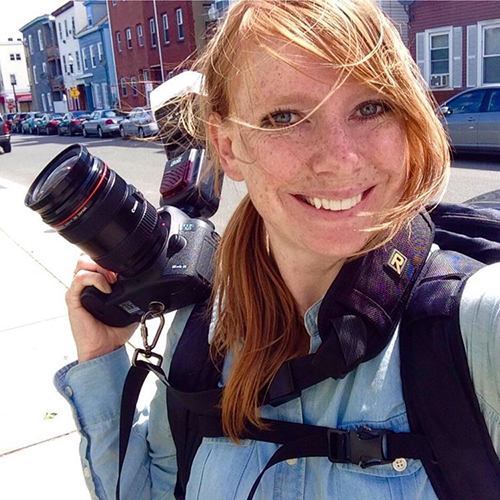
In the Field
Conservation Photography and Visual Storytelling
Instructor: Lauren Owens Lambert
Prerequisite: Students are expected to know the fundamentals of digital photography.
Course fee: $675
Option to pay 25% deposit now with balance due one week before course starts.

Danny Chea, Macro Algae Hatchery Technician with Running Tide, removes the kelp to weigh and photograph each piece at the Running Tide macro algae hatchery in Brunswick Maine. Photo by Lauren Owens Lambert
Class Description
This workshop will take photographers who are passionate about nature and science to the next level of visual storytelling.
Want to get out in the field with your camera? Want your photography to educate people about science and the environment? This two-and-a-half-day workshop will focus on conservation photography and documenting the work of biologists in the field. You will learn lighting, lens options, in-the-field studio setups, and anything else you need to get as many different kinds of photographs in one day with minimal equipment. Our goal at the end of this class is for each student to have a set of images that can effectively tell the story of the day or whatever other focus you may choose; the science, the environment, the people, or the wildlife. Have fun, ask questions and think creatively.
Through a partnership with Manomet, a Massachusetts south shore environmental education center, we will join their scientists and help communicate the work of Manomet with impactful imagery. The opportunity to share your work with Manomet is offered and encouraged in this partnership. With your permission, Manomet will use the photography created by you on their website and any educational materials. This is a chance to learn, explore, and get published. We will go over story construction, how to be a responsible wildlife photographer and how to work with scientists and organizations to accomplish goals and get your work out to a wider public.
Introduction Meeting
Thursday, April 18, 7:00–9:00 pm via Zoom
We will start with a virtual two hour Zoom meeting prior to heading into the field to meet the class, review the schedule, check the weather and talk about our expectations and what to bring for our day in the field. In preparation for sharing your images with Manomet at the end of the class, we will go over some basic copyright information, licensing options, and model release forms.
Field Day
Thursday, April 25, 5:30 am–1:30 pm
Manoment Conservation Research Center, Plymouth, MA
(Back up weather date April 26)
For the field day, the students will join Lauren while photographing research at the Manomet bird banding lab in Plymouth, Massachusetts. We will meet before dawn and in the field ready when the biologist team is setting up their 50 mist nets to catch, band and monitor migrating birds. We will learn about conservation communication sensitivities, respect for wildlife, and the scientific work being done while also communicating the story in interesting and creative ways.
As the day unfolds, we will follow the biologists back to the lab where they work with the birds in recording biological data, administering identification bands and recording species. In this class you will learn how to work with scientists and wildlife and how to capture powerful and intimate images to effectively tell the story of migration in this location.
Review Day
Thursday, May 2, 10:00 am – 4:00 pm
Manoment Conservation Research Center, Plymouth, MA
We will end the workshop with a day in the classroom at the Manomet headquarters to review your work and critique our favorite images. Students are asked to narrow down their shoot during the previous week prior. You will be showing what you feel are your top 10-15 images and we will together narrow them down to the final 3-5 images that can tell a compelling story. We will go through what works and what could be improved as we review your work. We will talk about caption information, and how to write an accurate and educational post for social media.
What to bring in the field
Try to keep it to two bags—one with your camera equipment and the other with food, layers, and maybe some overflow equipment.
Lauren Owens Lambert
 Lauren Owens Lambert’s work has a creative focus in documenting the human aspect of conservation, climate change and our relationship with the natural world during the age of the anthropocene. In her work, she places people as part of natural cycles, a perspective that is sometimes lost in contemporary society. Her work has been published with National Geographic, Audubon Magazine, BioGraphic, Smithsonian Magazine and National Wildlife Magazine. She freelances with news organizations such as Agence France-Presse and Reuters. She is an Associate Fellow at the International League of Conservation Photographers and a contributing photographer with Everyday Extinction and Everyday Climate Change. Lauren has shown in exhibitions at Photoville and has presented work at the United Nations on the importance of visual storytelling with ocean science and data communication.
Lauren Owens Lambert’s work has a creative focus in documenting the human aspect of conservation, climate change and our relationship with the natural world during the age of the anthropocene. In her work, she places people as part of natural cycles, a perspective that is sometimes lost in contemporary society. Her work has been published with National Geographic, Audubon Magazine, BioGraphic, Smithsonian Magazine and National Wildlife Magazine. She freelances with news organizations such as Agence France-Presse and Reuters. She is an Associate Fellow at the International League of Conservation Photographers and a contributing photographer with Everyday Extinction and Everyday Climate Change. Lauren has shown in exhibitions at Photoville and has presented work at the United Nations on the importance of visual storytelling with ocean science and data communication.
Payment and Cancellation Policies